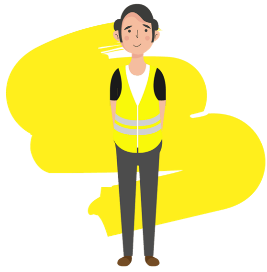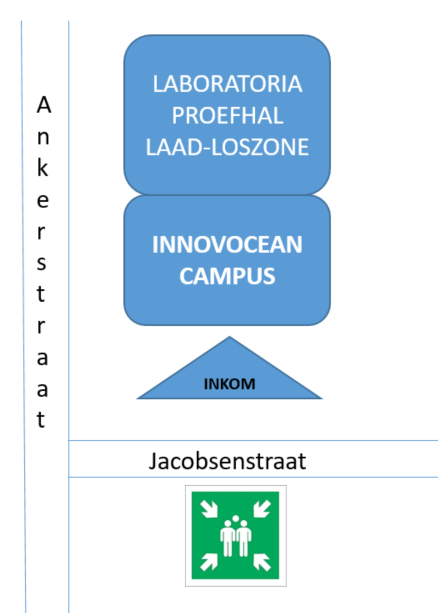Evacuation
Upon hearing the evacuation signal (continuous signal) or by order of the evacuation supervisors, stop your activity and immediately exit the building through the nearest emergency exit. Visitors will receive instructions from their hosts.
- Stop your work activities. Stay calm.
- Don't search for your possessions. Only if they are immediately at hand, you can bring personal small items (coat, phone, keys, badge, wallet, etc.).
- Close windows and doors.
- Leave the building immediately via the nearest emergency exit. Never use an elevator when doing so.
- Go to the meeting place (see below).
- If the signal should stop after some time, simply continue the evacuation to avoid opposing currents. Only after confirmation by the evacuation leader can you re-enter the building.
This building has an evacuation procedure that takes into account the daily changes in attendance. The principle is that during an evacuation, any employee present can take on one of the 2 following roles: evacuation closer or evacuation guide.
- The evacuation closer is the person that first arrives at an emergency exit with an evacuation kit, assigns an evacuation guide and then searches the zone for people who may be left behind.
- The evacuation guide, is the person who in the meanwhile goes to the meeting place holding the zone sign so everyone knows where to gather.
- The building coordinator (or deputy) takes on the role of evacuation leader and puts on the orange reflective vest. This person leads the evacuation and will possibly give additional instructions. The evacuation leader gives the signal that you may re-enter the building.
Evacuation closer
When the evacuation alarm goes off, leave your office and proceed immediately to the emergency exit.
Upon arrival at the closest emergency exit, you see that the evacuation kit is still there. This means that you are the first one. You spontaneously take on the role of evacuation closer.
Open the box, put on the yellow vest and take out the necessary materials. Assign a colleague to be the evacuation guide and perform your tasks.
Your main task as evaluation closer is to make sure that everyone has left the zone.
At the meeting place, you report about this to the evacuation leader (person wearing the orange vest).
Instructions for the 'evacuation closer'
- Put on the yellow vest
- Assign an evacuation guide and give them the action map for the evacuation guide
- Take the ‘zone control’ checklist
- Double-check that everyone has left the zone (meeting rooms, other rooms, bathrooms, ...)
- Send people with reduced mobility to the agreed-upon waiting area
- Note your observations in the ‘zone control' checklist
- Leave the building yourself via the (fire) stairs
- Inform the evacuation leader (orange vest):
- Zone evacuated?
- Anyone waiting in the agreed-upon waiting area?

Evacuation guide
You arrive at the nearest emergency exit and the evacuation closer designates you as the evacuation guide.
You put on a yellow vest and perform your tasks.
Your main task is to ensure that your colleagues – once they have arrived at the meeting place – know where they should wait until they may re-enter the building.
Instructions for the 'evacuation guide'
- Put on a yellow vest
- Take the zone sign
- Go immediately via the (fire) staircase to the meeting place and take the evacuation box with you
- Hold the zone sign up so it is clearly visible
- Wait for the signal of the evacuation leader to re-enter the building

People with reduced mobility
Are you (temporarily) less mobile and have difficulty using the stairs? If so, please go to the agreed "waiting zone" during the evacuation.
On each floor there is a location where you (because of your reduced mobility) can wait for help during an evacuation. This temporary assembly point is marked with a green pictogram.
At this location you wait for the arrival of the building coordinator (or an appointed evacuation manager) or the fire department.
You will usually find the waiting areas at the elevator or at the emergency exit to the terraces. If there are several emergency exits, the temporary assembly area can be located at one emergency exit or in between.
Inform your colleagues and the evacuation closer (person wearing the yellow jacket) that you will be waiting at the pictogram of the temporary waiting area, so that they can inform the evacuation leader (person wearing the orange vest).
You can't find the temporary waiting zone? Ask your supervisor about it.

Meeting place
In the event of evacuation, everyone proceeds immediately to the nearest emergency exit. Gather on the grounds at the front of the building on Jacobsen Street. There, you proceed to the appropriate zone sign and sign in with the evacuation guide. Then you wait for further instructions.
The assembly point is indicated by a green pictogram. The zone signs are indicated by a number.

Re-entering the building
Fire department intervention: in case of fire department intervention, only the main commander / evacuation leader of the intervention team can give permission to re-enter the building.
Evacuation drill or false alarm: after a drill or upon determination of a false alarm, the building is released for re-entry by the executive director, in consultation with the building coordinator. Together with the evacuation guides, they ensure a streamlined return to the workplace.
Evacuation outside of normal office hours
- Immediately leave the building when you hear the evacuation signal.
- Give your visitors and guests the necessary instructions. Visitors follow the instructions of their hosts.
- Go to the meeting place.
- The signal will be passed on to the control room where the procedures are followed, including contacting the fire department if needed. The control room automatically contacts the building coordinator (or deputy) who comes to inspect the building.
- When the fire department gets involved, only the commander in chief of the intervention team can give permission to re-enter the building.
- When a false alarm has been confirmed, the control room releases the building.